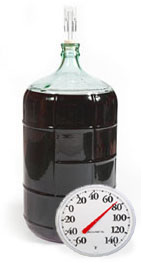 I started out wrong by air-locking my vessel from the start. I have two 5 gallon carboys; one containing Ruby Cabernet and the other French Colombard. The second mistake I made was to allow the juice to get too cold; below 40 degrees. I have since brought the juice home to a warmer atmosphere, where the French Colombard began to produce tiny bubbles, whereby popping at the air gap device; however, the Ruby is lying dormant. How should I proceed from here?
I started out wrong by air-locking my vessel from the start. I have two 5 gallon carboys; one containing Ruby Cabernet and the other French Colombard. The second mistake I made was to allow the juice to get too cold; below 40 degrees. I have since brought the juice home to a warmer atmosphere, where the French Colombard began to produce tiny bubbles, whereby popping at the air gap device; however, the Ruby is lying dormant. How should I proceed from here?
Name: Mark S.
State: PA
—–
Hello Mark,
The first thing that needs to be pointed out is that there is that there is absolutely no way that a wine yeast will ferment at 40°F. The fermentation temperature is too low. This is by far the most critical issue of the two. It will take some time for the carboys to warm up, but by the time you get this message hopefully they will be at a temperature that is more suitable to a fermentation (70°F. – 75°F.). Just realize that this is an absolute. The fermentation will not work at a temperature of 40°F. It’s just too low.
Having an airlock on the primary fermenter can hinder or slow the fermentation, but it is not an absolute. Rarely is using an air-lock during this time the root cause of a stuck fermentation.
Just think of the airlock as the icing-on-the-cake to your stuck fermentation. Both the low fermentation temperature and the airlock are working in concert to keep your fermentation from happening, but the fermentation temperature being too low is the main reason.
At this point you will want to leave the airlocks on both carboys until you do see some fermentation activity as the temperature rises. This is to protect the wine must from spoilage while it is still. Once you see some signs of fermentation, then you can safely take the air-locks off.
Signs of fermentation would be things like seeing bubbles rise along the side wall of the carboys or little patches of foam on the surface of the wine must. Do not rely on the airlock bubbling as an indicator. Bubbling will occur without the fermentation simply because the liquid is expanding from being warmed up. The expansion is causing the air in the head-space to forced out through the airlock.
In the future I would suggest starting the fermentation in a bucket fermenter as opposed to the carboys you are using for your primary fermentation. While taking the airlocks off the carboys is an improvement, the smaller opening restricts the amount of air that can get to the wine must. You can use the carboys with air-locks, later, after your first racking. This is when you want to minimize head-space with the wine, and carboys are great for doing this. Here’s some more information on why you do not what you use an airlock on a primary fermenter.
Once you do these simple things I do not expect you to have any more problems with getting your fermentation started, but if by chance you do not get one or both of them sufficiently going, I would suggest looking over the Top 10 Reasons For Fermentation Failure. See if any of the other 8 reasons ring a bell. Then take the corrective action.
Thank you for the great question and allowing me to share it with other winemakers. Having a fermentation temperature too low and using an airlock on a primary fermenter are both common beginner mistakes that need to be pointed out from time to time.
Happy Winemaking,
Ed Kraus
———————————————————————————————————
Ed Kraus is a 3rd generation home brewer/winemaker and has been an owner of E. C. Kraus since 1999. He has been helping individuals make better wine and beer for over 25 years.

I plan on using a water distiller! When is the best time to run good wine/ brandy through it?
Carl, anytime after the fermentation will work fine, but I would wait until the wine has completely cleared and was to a point that it could be bottled.